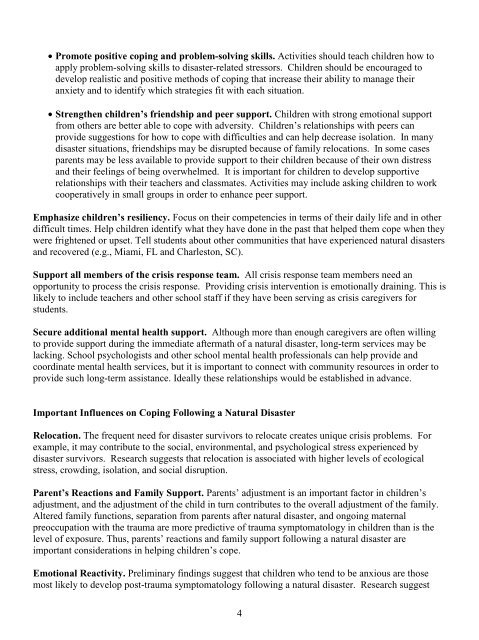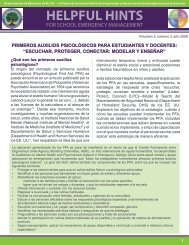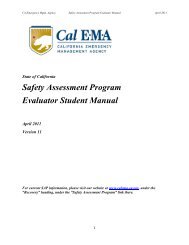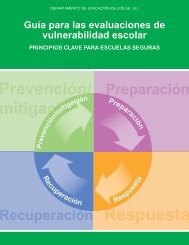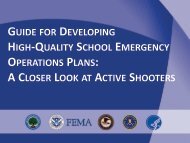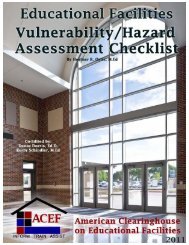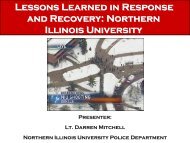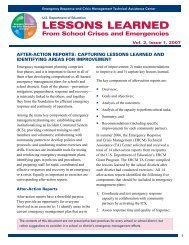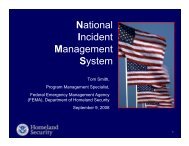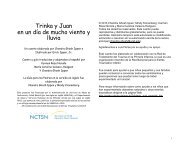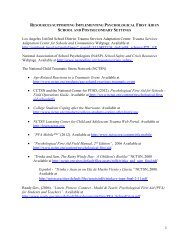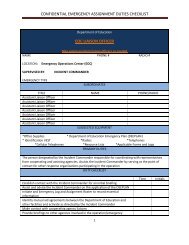Responding to Natural Disasters - National Association of School ...
Responding to Natural Disasters - National Association of School ...
Responding to Natural Disasters - National Association of School ...
Create successful ePaper yourself
Turn your PDF publications into a flip-book with our unique Google optimized e-Paper software.
Promote positive coping and problem-solving skills. Activities should teach children how <strong>to</strong>apply problem-solving skills <strong>to</strong> disaster-related stressors. Children should be encouraged <strong>to</strong>develop realistic and positive methods <strong>of</strong> coping that increase their ability <strong>to</strong> manage theiranxiety and <strong>to</strong> identify which strategies fit with each situation. Strengthen children’s friendship and peer support. Children with strong emotional supportfrom others are better able <strong>to</strong> cope with adversity. Children’s relationships with peers canprovide suggestions for how <strong>to</strong> cope with difficulties and can help decrease isolation. In manydisaster situations, friendships may be disrupted because <strong>of</strong> family relocations. In some casesparents may be less available <strong>to</strong> provide support <strong>to</strong> their children because <strong>of</strong> their own distressand their feelings <strong>of</strong> being overwhelmed. It is important for children <strong>to</strong> develop supportiverelationships with their teachers and classmates. Activities may include asking children <strong>to</strong> workcooperatively in small groups in order <strong>to</strong> enhance peer support.Emphasize children’s resiliency. Focus on their competencies in terms <strong>of</strong> their daily life and in otherdifficult times. Help children identify what they have done in the past that helped them cope when theywere frightened or upset. Tell students about other communities that have experienced natural disastersand recovered (e.g., Miami, FL and Charles<strong>to</strong>n, SC).Support all members <strong>of</strong> the crisis response team. All crisis response team members need anopportunity <strong>to</strong> process the crisis response. Providing crisis intervention is emotionally draining. This islikely <strong>to</strong> include teachers and other school staff if they have been serving as crisis caregivers forstudents.Secure additional mental health support. Although more than enough caregivers are <strong>of</strong>ten willing<strong>to</strong> provide support during the immediate aftermath <strong>of</strong> a natural disaster, long-term services may belacking. <strong>School</strong> psychologists and other school mental health pr<strong>of</strong>essionals can help provide andcoordinate mental health services, but it is important <strong>to</strong> connect with community resources in order <strong>to</strong>provide such long-term assistance. Ideally these relationships would be established in advance.Important Influences on Coping Following a <strong>Natural</strong> DisasterRelocation. The frequent need for disaster survivors <strong>to</strong> relocate creates unique crisis problems. Forexample, it may contribute <strong>to</strong> the social, environmental, and psychological stress experienced bydisaster survivors. Research suggests that relocation is associated with higher levels <strong>of</strong> ecologicalstress, crowding, isolation, and social disruption.Parent’s Reactions and Family Support. Parents’ adjustment is an important fac<strong>to</strong>r in children’sadjustment, and the adjustment <strong>of</strong> the child in turn contributes <strong>to</strong> the overall adjustment <strong>of</strong> the family.Altered family functions, separation from parents after natural disaster, and ongoing maternalpreoccupation with the trauma are more predictive <strong>of</strong> trauma symp<strong>to</strong>ma<strong>to</strong>logy in children than is thelevel <strong>of</strong> exposure. Thus, parents’ reactions and family support following a natural disaster areimportant considerations in helping children’s cope.Emotional Reactivity. Preliminary findings suggest that children who tend <strong>to</strong> be anxious are thosemost likely <strong>to</strong> develop post-trauma symp<strong>to</strong>ma<strong>to</strong>logy following a natural disaster. Research suggest4


